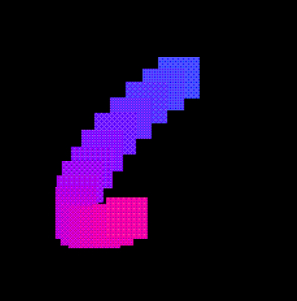概要
標準C++のみではグラフィックスが描画できないが、Sixel対応ターミナルを使えばグラフィックス描画できる。
Windowsでの対応ターミナル
- Windows Terminal Preview 1.22以降
- Mintty
が対応している。
2024/9現在、PreviewでないWindows Terminalがあと少しで対応しそうで、対応したら活用が進むかもしれない。
Sixelとは?
が主要な情報源に思われる。まとめると、
単位:
- 幅x高が1x6ピクセルのまとまりをSixelと呼ぶ
- 高さ6ピクセルの帯をSixel行と呼ぶ
色:
- 256色のパレットで色を扱う(256色以上扱えるターミナルもあるが未調査)
- 1文字のSixelでは一色しか表現できない
- 同一のSixel位置で複数色を表現したい場合は、キャリッジリターン後に同じ位置まで進め重ね書きする
描画位置の変更手段:
- Sixel出力:1文字のSixel出力で1Sixel分だけ右に移動する
- キャリッジリターン(
$):現Sixel行の先頭に移動する - 改行(
-):次のSixel行の先頭に移動する
基本処理
1つのSixel行について、
- Sixel内の上から1番目のピクセルのみ書いていきキャリッジリターン
- 同一Sixel行においてSixel内の上から2番目のピクセルのみ書いていきキャリッジリターン
- 同一Sixel行においてSixel内の上から3番目のピクセルのみ書いていきキャリッジリターン
- ...
- 同一Sixel行においてSixel内の上から6番目のピクセルのみ書いていき改行
とすれば、効率は悪いけれど簡単に変換できそう。また、効率を良くしてもワーストケースではこうなりそう。
これを実装すると、
#include <cstdint>
#include <format>
#include <iostream>
#include <string>
#include <vector>
using std::format;
using std::string;
using std::vector;
struct Color { uint8_t r, g, b, a; };
string toSixel(const vector<Color>& palette, vector<uint8_t> data, int w) {
int h = data.size() / w;
string s{"\x1bPq"};
s += format("\"1;1;{};{}", w, h);
for (int i = 0; auto color : palette) {
auto to100 = [](uint8_t c) { return c * 100 / 255; };
s += format("#{};2;{};{};{}", i++, to100(color.r), to100(color.g), to100(color.b));
}
for (int y = 0; y < h; ++y) {
for (int x = 0; x < w; ++x) {
uint8_t i = data[y * w + x];
s += format("#{}", i);
s += '?' + (1 << y % 6);
}
s += (y % 6 == 6 - 1) ? '-' : '$';
}
s += "\x1b\\";
return s;
}
int main() {
vector<Color> palette = {{0, 0, 0}, {255, 0, 0}, {0, 255, 0}, {0, 0, 255}};
vector<uint8_t> data = {
3, 1, 1, 1, 1, 1, 1, 3,
1, 1, 0, 0, 0, 0, 1, 1,
1, 0, 0, 2, 2, 0, 0, 1,
1, 0, 2, 3, 3, 2, 0, 1,
1, 0, 2, 3, 3, 2, 0, 1,
1, 0, 0, 2, 2, 0, 0, 1,
1, 1, 0, 0, 0, 0, 1, 1,
3, 1, 1, 1, 1, 1, 1, 3,
};
int dataWidth = 8;
std::cout << toSixel(palette, data, dataWidth) << std::endl;
}
となり、
$ clang++ -std=c++20 -O2 sixel.cpp
でコンパイルする。
これで、パレットと配列を指定した描画ができた。
拡大
小さくて確認しづらいのでSixel化する前に拡大しよう。(これ自体はSixelに依存した処理ではない)
後にRGBA8データにも使えるようテンプレートにしている。
template <class T>
vector<T> toScaled(const vector<T>& data, int w, int s) {
int h = data.size() / w;
vector<T> outData;
outData.reserve(s * w * s * h);
for (int y = 0; y < h; ++y) {
for (int yi = 0; yi < s; ++yi) {
for (int x = 0; x < w; ++x) {
T c = data[y * w + x];
for (int xi = 0; xi < s; ++xi) {
outData.push_back(c);
}
}
}
}
return outData;
}
int main() {
// ...
int s = 8;
auto scaledData = toScaled(data, dataWidth, s);
int scaledDataWidth = s * dataWidth;
std::cout << toSixel(palette, scaledData, scaledDataWidth) << std::endl;
}
RGBA8処理
RGBA8を処理するには、パレットありデータに変換すればよい。
パレットは最大256色までなのでRGBの各成分を2ビットで表現して、64色のパレットで表現することにする。
(これもSixelに依存した処理ではない)
2ビットだと4諧調しか表現できず表現力が低すぎるので、簡単なディザリングも実装する。
vector<Color> createRgb2Palette() {
vector<Color> palette;
for (int ri = 0; ri < 4; ++ri) {
for (int gi = 0; gi < 4; ++gi) {
for (int bi = 0; bi < 4; ++bi) {
auto to255 = [](int i) { return static_cast<uint8_t>(i * 255 / (4 - 1)); };
palette.push_back({to255(ri), to255(gi), to255(bi)});
}
}
}
return palette;
}
vector<uint8_t> toDataForRgb2Palette(const vector<Color>& data, int w) {
int h = data.size() / w;
vector<uint8_t> outData;
outData.reserve(w * h);
for (int y = 0; y < h; ++y) {
for (int x = 0; x < w; ++x) {
const Color& c = data[y * w + x];
auto to4 = [](int mod4X, int mod4Y, uint8_t cc) {
static uint8_t dither[4][4] = {
0x0, 0x8, 0x2, 0xa,
0xc, 0x4, 0xe, 0x6,
0x3, 0xb, 0x1, 0x9,
0xf, 0x7, 0xd, 0x5,
};
int i49 = cc * 49 / 256;
return i49 / 16 + (dither[mod4Y][mod4X] < i49 % 16);
};
int mod4X = x % 4, mod4Y = y % 4;
uint8_t i = (
(to4(mod4X, mod4Y, c.r) << 4) +
(to4(mod4X, mod4Y, c.g) << 2) +
(to4(mod4X, mod4Y, c.b) << 0));
outData.push_back(i);
}
}
return outData;
}
4x4ディザリングありでの諧調は49諧調になる。
これは、2ビットは4諧調で、それぞれの間の4x4ディザリングが16諧調なので、16 * (4 - 1) + 1 = 49 から求まる。
これで変換してパレットありデータにし、対応したパレットとともに、toSixel に渡せばRGBA8のSixel文字列が生成できる。
RGBA8の動作確認
動作確認のために簡単な矩形塗り関数を作ろう。
#include <algorithm>
// ...
void fillRect(vector<Color>& data, int dataW, int x, int y, int w, int h, const Color& color) {
int dataH = data.size() / dataW;
int sx = std::clamp(x, 0, dataW);
int sy = std::clamp(y, 0, dataH);
int ex = std::clamp(x + w, 0, dataW);
int ey = std::clamp(y + h, 0, dataH);
for (int yi = sy; yi < ey; ++yi) {
for (int xi = sx; xi < ex; ++xi) {
data[yi * dataW + xi] = color;
}
}
}
あとは、適当に描画する。
#include <cmath>
// ...
int main() {
for (int ti = 0; ti < 10000; ++ti) {
int w = 256, h = 256;
vector<Color> data(w * h);
for (int i = 0; i < 16; ++i) {
Color c{
static_cast<uint8_t>(128 + 127.9f * std::sin(0.03f * ti + 0.1f * i)),
static_cast<uint8_t>(128 + 127.9f * std::sin(0.04f * ti + 0.1f * i)),
static_cast<uint8_t>(128 + 127.9f * std::sin(0.05f * ti + 0.1f * i)),
};
int x = 128 + 64 * std::cos(0.05f * ti + 0.2f * i) - 16;
int y = 128 + 64 * std::sin(0.06f * ti + 0.2f * i) - 16;
fillRect(data, w, x, y, 32, 32, c);
}
std::cout << toSixel(createRgb2Palette(), toDataForRgb2Palette(data, w), w) << std::endl;
}
}
ループで描画しつづければアニメーションに見せることもできる。
まとめ
簡単なグラフィックス表示を標準C++だけでできるようになりそう。



